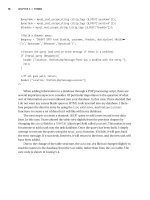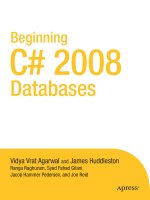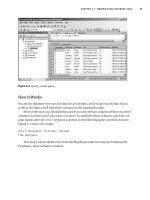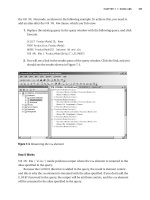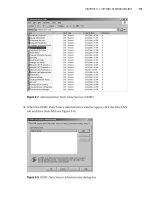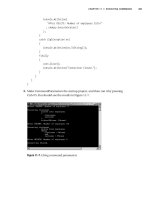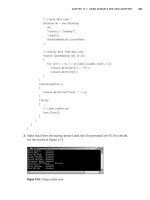Beginning C# 2005 Databases From Novice to Professional phần 5 doc
Bạn đang xem bản rút gọn của tài liệu. Xem và tải ngay bản đầy đủ của tài liệu tại đây (720.1 KB, 52 trang )
// set sort
string srt = "companyname asc";
// display filtered and sorted data
foreach (DataRow row in dtc["customers"].Select(fl, srt))
{
Console.WriteLine(
"{0}\t{1}",
row["CompanyName"].ToString().PadRight(25),
row["ContactName"]);
}
// display data from second data table
//
// display output header
Console.WriteLine("\n ");
Console.WriteLine("Results from Products table:");
Console.WriteLine(
"ProductName".PadRight(20) +
"UnitPrice".PadLeft(21) + "\n");
// display data
foreach (DataRow row in dtc[1].Rows)
{
Console.WriteLine("{0}\t{1}",
row["productname"].ToString().PadRight(25),
row["unitprice"]);
}
}
catch(Exception e)
{
Console.WriteLine("Error: " + e);
}
finally
{
// close connection
conn.Close();
}
}
}
}
CHAPTER 8 ■ INTRODUCING DATASETS AND DATA ADAPTERS 183
777Xch08final.qxd 11/18/06 2:44 PM Page 183
3. Make this the startup project, and run it with Ctrl+F5. You should see the result
shown in Figure 8-4.
How It Works
You code and combine two queries for execution on the same connection:
// query 1
string sql1 = @"
select
*
from
customers
";
// query 2
string sql2 = @"
select
*
from
products
where
unitprice < 10
";
CHAPTER 8 ■ INTRODUCING DATASETS AND DATA ADAPTERS184
Figure 8-4. Filtering and sorting a data table
777Xch08final.qxd 11/18/06 2:44 PM Page 184
// combine queries
string sql = sql1 + sql2;
// create connection
SqlConnection conn = new SqlConnection(connString);
You create a data adapter, assigning to its SelectCommand property a command that
encapsulates the query and connection (for internal use by the data adapter’s
Fill
method):
// create data adapter
SqlDataAdapter da = new SqlDataAdapter();
da.SelectCommand = new SqlCommand(sql, conn);
You then create and fill a dataset:
// create and fill dataset
DataSet ds = new DataSet();
da.Fill(ds, "customers");
Each query returns a separate result set, and each result set is stored in a separate
data table (in the order in which the queries were specified). The first table is explicitly
named
customers; the second is given the default name customers1.
You get the data table collection from the dataset
Tables property for ease of refer-
ence later:
// get the data tables collection
DataTableCollection dtc = ds.Tables;
As part of displaying the first data table, you declare two strings:
// set display filter
string fl = "country = 'Germany'";
// set sort
string srt = "companyname asc";
The first str
ing is a
filter e
xpr
ession
that specifies r
o
w-selection cr
iter
ia. It’s syntacti-
cally the same as a SQL
WHERE clause pr
edicate
.
Y
ou want only rows where the
Country
column equals 'Germany'.
The second str
ing specifies y
our sor
t criteria and is syntacti-
cally the same as a SQL
ORDER BY clause
, giving a data column name
and sor
t sequence
.
Y
ou use a
foreach loop to display the r
o
ws selected fr
om the data table, passing the
filter and sor
t str
ings to the
Select method of the data table
.
This par
ticular data table is
the one named
customers in the data table collection:
CHAPTER 8 ■ INTRODUCING DATASETS AND DATA ADAPTERS 185
777Xch08final.qxd 11/18/06 2:44 PM Page 185
// display filtered and sorted data
foreach (DataRow row in dtc["customers"].Select(fl, srt))
{
Console.WriteLine(
"{0}\t{1}",
row["CompanyName"].ToString().PadRight(25),
row["ContactName"]);
}
You obtain a reference to a single data table from the data table collection (the dtc
object) using the table name that you specified when creating the dataset. The over-
loaded
Select method does an internal search on the data table, filters out rows not
satisfying the selection criterion, sorts the result as prescribed, and finally returns an
array of data rows. You access each column in the row, using the column name in the
indexer.
It’s important to note that you could have achieved the same result—much more
efficiently—had you simply used a different query for the
Customer data:
select
*
from
customers
where
country = 'Germany'
order by
companyname
This would be ideal in terms of performance, but it’d be feasible only if the data you
need were limited to these specific rows in this particular sequence. However, if you were
building a more elaborate system, it might be better to pull all the data once from the
database (as you do here) and then filter and sort it in different ways. ADO.NET’s rich
suite of methods for manipulating datasets and their components gives you a broad
range of techniques for meeting specific needs in an optimal way.
■T
ip
In general,
tr
y to exploit SQL,
ra
ther than code C# procedures, to get the data you need from the
database. Database servers are optimized to perform selections and sorts, as well as other things. Queries
can be far more sophisticated and powerful than the ones you’ve been playing with in this book. By care-
fully (and creatively) coding queries to return
exactly what you need, you not only minimize resource
demands (on memory, network bandwidth, and so on), but you also reduce the code you must write to
manipulate and format result set data.
CHAPTER 8 ■ INTRODUCING DATASETS AND DATA ADAPTERS186
777Xch08final.qxd 11/18/06 2:44 PM Page 186
The loop through the second data table is interesting mainly for its first line
foreach (DataRow row in dtc[1].Rows)
which uses an ordinal index. Since you don’t rename the second data table (you could
have done so with its
TableName property), it’s better to use the index rather than the
name (
customers1), since a change to the name in the Fill() call would require you to
change it here, an unlikely thing to remember to do, if the case ever arose.
Comparing FilterSort to PopDataSet
In the first example, PopDataSet (Listing 8-1), you saw how simple it is to get data into
a dataset. The second example,
FilterSort (Listing 8-2), was just a variation, demonstrat-
ing how multiple result sets are handled and how to filter and sort data tables. However,
the two programs have one major difference. Did you notice it?
FilterSort doesn’t explicitly open a connection! In fact, it’s the first (but won’t be the
last) program you’ve written that doesn’t. Why doesn’t it?
The answer is simple but
very important. The Fill method automatically opens
a connection if it’s not open when
Fill() is called. It then closes the connection after
filling the dataset. However, if a connection is open when
Fill() is called, it uses that
connection and
doesn’t close it afterward.
So, although datasets are completely independent of databases (and connections),
just because you’re using a dataset doesn
’t mean you’re running disconnected from a
database. If you want to run disconnected, use datasets, but don’t open connections
before filling them (or, if a connection is open, close it first). Datasets in themselves
don’t imply either connected or disconnected operations.
You left the standard
conn.Close(); in the finally block. Since you can call Close()
without error on a closed connection, it presents no problems if called unnecessarily,
but it definitely guarantees that the connection will be closed, whatever may happen in
the
try block.
■Note If you want to prove this for yourself, simply open the connection in FilterSort before calling
Fill() and then display the value of the connection’s State property. It will be Open. Comment out the
Open() call, and run it again. State will be closed.
Using Data Views
In the previous example, you saw how to dynamically filter and sort data in a data table
using the
Select method. However, ADO.NET has another approach for doing much the
CHAPTER 8 ■ INTRODUCING DATASETS AND DATA ADAPTERS 187
777Xch08final.qxd 11/18/06 2:44 PM Page 187
same thing and more: data views. A data view (an instance of class System.Data.DataView)
enables you to create dynamic views of the data stored in an underlying data table,
reflecting all the changes made to its content and its ordering. This differs from the
Select method, which returns an array of data rows whose contents reflect the changes
to data values but not the data ordering.
■Note A data view is a dynamic representation of the contents of a data table. Like a SQL view, it doesn’t
actually hold data.
Try It Out: Refining Data with a Data View
We won’t cover all aspects of data views here, as they’re beyond the scope of this book.
However, to show how you can use them, we’ll present a short example that uses a data
view to dynamically sort and filter an underlying data table:
1. Add a new C# Console Application project named DataViews to your Chapter08
solution. Rename Program.cs to DataViews.cs.
2. Replace the code in DataViews.cs with the code in Listing 8-3.
Listing 8-3. DataViews.cs
using System;
using System.Data;
using System.Data.SqlClient;
namespace Chapter08
{
class DataViews
{
static void Main(string[] args)
{
// connection string
string connString = @"
server = .\sqlexpress;
integrated security = true;
database = northwind
";
CHAPTER 8 ■ INTRODUCING DATASETS AND DATA ADAPTERS188
777Xch08final.qxd 11/18/06 2:44 PM Page 188
// query
string sql = @"
select
contactname,
country
from
customers
";
// create connection
SqlConnection conn = new SqlConnection(connString);
try
{
// Create data adapter
SqlDataAdapter da = new SqlDataAdapter();
da.SelectCommand = new SqlCommand(sql, conn);
// create and fill dataset
DataSet ds = new DataSet();
da.Fill(ds, "customers");
// get data table reference
DataTable dt = ds.Tables["customers"];
// create data view
DataView dv = new DataView(
dt,
"country = 'Germany'",
"country",
DataViewRowState.CurrentRows
);
// display data from data view
foreach (DataRowView drv in dv)
{
for (int i = 0; i < dv.Table.Columns.Count; i++)
Console.Write(drv[i] + "\t");
Console.WriteLine();
}
}
CHAPTER 8 ■ INTRODUCING DATASETS AND DATA ADAPTERS 189
777Xch08final.qxd 11/18/06 2:44 PM Page 189
catch(Exception e)
{
Console.WriteLine("Error: " + e);
}
finally
{
// close connection
conn.Close();
}
}
}
}
3. Make this the startup project, and run it with Ctrl+F5. You should see the result
shown in Figure 8-5.
How It Works
This program is basically the same as the other examples, so we’ll focus on its use of a
data view
. You create a new data view and initialize it by passing four parameters to its
constr
uctor:
// create data view
DataView dv = new DataView(
dt,
"country = 'Germany'",
"country",
DataViewRowState.CurrentRows
);
CHAPTER 8 ■ INTRODUCING DATASETS AND DATA ADAPTERS190
Figure 8-5. Using a data view
777Xch08final.qxd 11/18/06 2:44 PM Page 190
The first parameter is a data table, the second is a filter for the contents of the data
table, the third is the sort column, and the fourth specifies the types of rows to include
in the data view.
System.Data.DataViewRowState is an enumeration of states that rows can have in
a data view’s underlying data table. Table 8-1 summarizes the states.
Table 8-1. Data View Row States
DataViewRowState Member Description
Added A new row
CurrentRows Current rows, including unchanged, new, and modified ones
Deleted A deleted row
ModifiedCurrent The current version of a modified row
ModifiedOriginal The original v
ersion of a modified r
ow
None None of the rows
OriginalRows Original rows, including unchanged and deleted
Unchanged A row that hasn’t been modified
Every time you add, modify, or delete a row, its row state changes to the appropriate
one in Table 8-1. This is useful if you’re interested in retrieving, sorting, or filtering spe-
cific rows based on their state (for example, all new rows in the data table or all rows that
hav
e been modified).
You then loop through the rows in the data view:
// display data from data view
foreach (DataRowView drv in dv)
{
for (int i = 0; i < dv.Table.Columns.Count; i++)
Console.Write(drv[i] + "\t");
Console.WriteLine();
}
Just as a data row represents a single row in a data table, a data row view (perhaps
it would have been better to call it a
data view row) represents a single row in a data
view. You retrieve the filtered and the sorted column data for each data row view and
output it to the console.
As this simple example suggests, data views offer a powerful and flexible means of
dynamically changing what data one works with in a data table.
CHAPTER 8 ■ INTRODUCING DATASETS AND DATA ADAPTERS 191
777Xch08final.qxd 11/18/06 2:44 PM Page 191
Modifying Data in a Dataset
In the following sections, you’ll work through a practical example showing a number of
ways to update data in data tables programmatically. Note that here you’ll just modify
the data in the dataset but not update the data in the database. You’ll see in the “Propa-
gating Changes to a Data Source” section how to persist in the original data source
changes made to a dataset.
■Note Changes you make to a dataset aren’t automatically propagated to a database. To save the
changes in a database, you need to connect to the database again and explicitly perform the necessary
updates.
Try It Out: Modifying a Data Table in a Dataset
Let’s update a row and add a row in a data table:
1. Add a new C# Console Application project named ModifyDataTable to your
Chapter08 solution. Rename Program.cs to ModifyDataTable.cs.
2. Replace the code in ModifyDataTable.cs with the code in Listing 8-4.
Listing 8-4. ModifyDataTable.cs
using System;
using System.Data;
using System.Data.SqlClient;
namespace Chapter08
{
class ModifyDataTable
{
static void Main(string[] args)
{
// connection string
string connString = @"
server = .\sqlexpress;
integrated security = true;
database = northwind
";
CHAPTER 8 ■ INTRODUCING DATASETS AND DATA ADAPTERS192
777Xch08final.qxd 11/18/06 2:44 PM Page 192
// query
string sql = @"
select
*
from
employees
where
country = 'UK'
";
// create connection
SqlConnection conn = new SqlConnection(connString);
try
{
// create data adapter
SqlDataAdapter da = new SqlDataAdapter();
da.SelectCommand = new SqlCommand(sql, conn);
// create and fill dataset
DataSet ds = new DataSet();
da.Fill(ds, "employees");
// get data table reference
DataTable dt = ds.Tables["employees"];
// FirstName column should be nullable
dt.Columns["firstname"].AllowDBNull = true;
// modify City in first row
dt.Rows[0]["city"] = "Wilmington";
// add a row
DataRow newRow = dt.NewRow();
newRow["firstname"] = "Roy";
newRow["lastname"] = "Beatty";
newRow["titleofcourtesy"] = "Sir";
newRow["city"] = "Birmingham";
newRow["country"] = "UK";
dt.Rows.Add(newRow);
CHAPTER 8 ■ INTRODUCING DATASETS AND DATA ADAPTERS 193
777Xch08final.qxd 11/18/06 2:44 PM Page 193
// display Rows
foreach (DataRow row in dt.Rows)
{
Console.WriteLine(
"{0} {1} {2}",
row["firstname"].ToString().PadRight(15),
row["lastname"].ToString().PadLeft(25),
row["city"]);
}
//
// code for updating the database would come here
//
}
catch(Exception e)
{
Console.WriteLine("Error: " + e);
}
finally
{
// close connection
conn.Close();
}
}
}
}
3. Make this the startup project, and run it with Ctrl+F5. You should see the result
shown in Figure 8-6.
CHAPTER 8 ■ INTRODUCING DATASETS AND DATA ADAPTERS194
Figure 8-6. Modifying a data table
777Xch08final.qxd 11/18/06 2:44 PM Page 194
How It Works
As before, you use a single data table in a dataset:
/
/ get data table reference
DataTable dt = ds.Tables["employees"];
Next, you can see an example of how you can change the schema information. You
select the
FirstName column, whose AllowNull property is set to false in the database, and
you change it—just for the purposes of demonstration—to
true:
// FirstName column should be nullable
dt.Columns["firstname"].AllowDBNull = true;
Note that you could have used an ordinal index (for example, dt.Columns[1]) if you
knew what the index for the column was, but using
* to select all columns makes this
less reliable, since the position of a column may change if the database table schema
changes.
You can modify a row using the same technique. You simply select the appropriate
row and set its columns to whatever values you want, consistent with the column data
types, of course. The following line shows the
City column of the first row of the dataset
being changed to Wilmington:
// modify City in first row
dt.Rows[0]["city"] = "Wilmington";
Next you add a new r
ow to the data table:
// add a row
DataRow newRow = dt.NewRow();
newRow["firstname"] = "Roy";
newRow["lastname"] = "Beatty";
newRow["titleofcourtesy"] = "Sir";
newRow["city"] = "Birmingham";
newRow["country"] = "UK";
dt.Rows.Add(newRow);
The NewRow method cr
eates a data r
o
w (a
System.Data.DataRow instance).
Y
ou use the
data r
o
w
’s indexer to assign values to its columns. Finally, you add the new row to the
data table
, calling
the
Add method on the data table
’
s
Rows pr
oper
ty
, which references
the r
o
ws collection.
CHAPTER 8 ■ INTRODUCING DATASETS AND DATA ADAPTERS 195
777Xch08final.qxd 11/18/06 2:44 PM Page 195
Note that you don’t provide a value for EmployeeID, since it’s an IDENTITY column.
If you persist the changes to the database, then SQL Server will automatically provide
a value for it.
Updating data sources requires learning more about data adapter methods and
properties. Let’s take a look at these now.
Propagating Changes to a Data Source
You’ve seen how a data adapter populates a dataset’s data tables. What you haven’t
looked at yet is how a data adapter updates and synchronizes a data source with data
from a dataset. It has three properties that support this (analogous to its
SelectCommand
property that supports queries):
•
UpdateCommand
• InsertCommand
• DeleteCommand
We’ll describe each of these properties briefly and then put them to work.
UpdateCommand Property
The UpdateCommand property of the data adapter holds the command used to update the
data source when the data adapter’s
Update method is called.
For example, to update the
City column in the Employees table with the data from
a data table, one approach is to write code such as the following (where
da is the data
adapter,
dt is the data table, conn is the connection, and ds is the dataset):
// Create command to update Employees City column
da.UpdateCommand = new SqlCommand(
"update employees "
+ "set "
+ " city = "
+ "'" + dt.Rows[0]["city"] + "' "
+ "where employeeid = "
+ "'" + dt.Rows[0]["employeeid"] + "' "
, conn);
// Update Employees table
da.Update(ds, "employees");
CHAPTER 8 ■ INTRODUCING DATASETS AND DATA ADAPTERS196
777Xch08final.qxd 11/18/06 2:45 PM Page 196
This isn’t very pretty—or useful. Basically, you code an UPDATE statement and
embed two data column values for the first row in a data table in it. It’s valid SQL, but
that’s its only virtue, and it’s not much of one, since it updates only one database row—
the row in
Employees corresponding to the first data row in the employees data table.
Another approach works for any number of rows. Recall from the
CommandParameters
program in Chapter 6 how you used command parameters for INSERT statements. You can
use them in any query or data-manipulation statement. Let’s recode the previous code
with command parameters.
Try It Out: Propagating Dataset Changes to a Data Source
Let’s change the city in the first row of the Employees table and persist the change in the
database:
1. Add a new C# Console Application project named PersistChanges to your
Chapter08 solution. Rename Program.cs to PersistChanges.cs.
2. Replace the code in PersistChanges.cs with the code in Listing 8-5. (This is a vari-
ation on
ModifyDataTable.cs in Listing 8-4, with the nullability and insertion logic
removed, since they’re irrelevant here.)
Listing 8-5. PersistChanges.cs
using System;
using System.Data;
using System.Data.SqlClient;
namespace Chapter08
{
class PersistChanges
{
static void Main(string[] args)
{
// connection string
string connString = @"
server = .\sqlexpress;
integrated security = true;
database = northwind
";
CHAPTER 8 ■ INTRODUCING DATASETS AND DATA ADAPTERS 197
777Xch08final.qxd 11/18/06 2:45 PM Page 197
// query
string qry = @"
select
*
from
employees
where
country = 'UK'
";
// SQL to update employees
string upd = @"
update employees
set
city = @city
where
employeeid = @employeeid
";
// create connection
SqlConnection conn = new SqlConnection(connString);
try
{
// create data adapter
SqlDataAdapter da = new SqlDataAdapter();
da.SelectCommand = new SqlCommand(qry, conn);
// create and fill dataset
DataSet ds = new DataSet();
da.Fill(ds, "employees");
// get data table reference
DataTable dt = ds.Tables["employees"];
// modify city in first row
dt.Rows[0]["city"] = "Wilmington";
CHAPTER 8 ■ INTRODUCING DATASETS AND DATA ADAPTERS198
777Xch08final.qxd 11/18/06 2:45 PM Page 198
// display rows
foreach (DataRow row in dt.Rows)
{
Console.WriteLine(
"{0} {1} {2}",
row["firstname"].ToString().PadRight(15),
row["lastname"].ToString().PadLeft(25),
row["city"]);
}
// update Employees
//
// create command
SqlCommand cmd = new SqlCommand(upd, conn);
//
// map parameters
//
// City
cmd.Parameters.Add(
"@city",
SqlDbType.NVarChar,
15,
"city");
//
// EmployeeID
SqlParameter parm =
cmd.Parameters.Add(
"@employeeid",
SqlDbType.Int,
4,
"employeeid");
parm.SourceVersion = DataRowVersion.Original;
//
// Update database
da.UpdateCommand = cmd;
da.Update(ds, "employees");
}
catch(Exception e)
{
Console.WriteLine("Error: " + e);
}
CHAPTER 8 ■ INTRODUCING DATASETS AND DATA ADAPTERS 199
777Xch08final.qxd 11/18/06 2:45 PM Page 199
finally
{
// close connection
conn.Close();
}
}
}
}
3. Make this the startup project, and run it with Ctrl+F5. You should see the result
shown in Figure 8-7.
How It Works
You add an UPDATE statement and change the name of the original query string variable
from
sql to upd in order to clearly distinguish it from this statement:
// SQL to update employees
string upd = @"
update employees
set
city = @city
where
employeeid = @employeeid
";
You replace the update comment in the try block with quite a bit of code. Let’s look
at it piece by piece. Creating a command is nothing new, but notice that you use the
update SQL variable (
upd), not the query one (sql):
// update Employees
//
// create command
SqlCommand cmd = new SqlCommand(upd, conn);
CHAPTER 8 ■ INTRODUCING DATASETS AND DATA ADAPTERS200
Figure 8-7. Modifying a row
777Xch08final.qxd 11/18/06 2:45 PM Page 200
Then you configure the command parameters. The @city parameter is mapped to
a data column named
city. Note that you don’t specify the data table, but you must be
sure the type and length are compatible with this column in whatever data table you
eventually use:
// City
cmd.Parameters.Add(
"@city",
SqlDbType.NVarChar,
15,
"city");
Next, you configure the @employeeid parameter, mapping it to a data column
named
employeeid. Unlike @city, which by default takes values from the current version
of the data table, you want to make sure that
@employeeid gets values from the version
before any changes. Although it doesn’t really matter here, since you didn’t change any
employee IDs, it’s a good habit to specify the original version for primary keys, so if
they do change, the correct rows are accessed in the database table. Note also that you
save the reference returned by the
Add method so you can set its SourceVersion property.
Since you don’t need to do anything else with
@city, you don’t have to save a reference
to it:
// EmployeeID
SqlParameter parm =
cmd.Parameters.Add(
"@employeeid",
SqlDbType.Int,
4,
"employeeid");
parm.SourceVersion = DataRowVersion.Original;
Finally, you set the data adapter’s UpdateCommand property with the command to
update the
Employees table, so it will be the SQL the data adapter executes when you call
its
Update method. You then call Update on the data adapter to propagate the change to
the database. Here you have only one change, but since the SQL is parameterized, the
data adapter looks for all changed rows in the
employees data table and submits updates
for all of them to the database:
// Update database
da.UpdateCommand = cmd;
da.Update(ds, "employees");
CHAPTER 8 ■ INTRODUCING DATASETS AND DATA ADAPTERS 201
777Xch08final.qxd 11/18/06 2:45 PM Page 201
Figure 8-7 shows the change to the city, and if you check with Database Explorer or
the SSMSE, you’ll see the update has been propagated to the database. The city for
employee Steven Buchanan is now Wilmington, not London.
InsertCommand Property
The data adapter uses the InsertCommand property for inserting rows into a table. Upon
calling the
Update method, all rows added to the data table will be searched for and
propagated to the database.
Try It Out: Propagating New Dataset Rows to a Data Source
Let’s propagate a new row to the database, in another variation on ModifyDataTable.cs in
Listing 8-4:
1. Add a new C# Console Application project named PersistAdds to your Chapter08
solution. Rename Program.cs to PersistAdds.cs.
2. Replace the code in PersistAdds.cs with the code in Listing 8-6.
Listing 8-6. PersistAdds
using System;
using System.Data;
using System.Data.SqlClient;
namespace Chapter08
{
class PersistAdds
{
static void Main(string[] args)
{
// connection string
string connString = @"
server = .\sqlexpress;
integrated security = true;
database = northwind
";
CHAPTER 8 ■ INTRODUCING DATASETS AND DATA ADAPTERS202
777Xch08final.qxd 11/18/06 2:45 PM Page 202
// query
string qry = @"
select
*
from
employees
where
country = 'UK'
";
// SQL to insert employees
string ins = @"
insert into employees
(
firstname,
lastname,
titleofcourtesy,
city,
country
)
values
(
@firstname,
@lastname,
@titleofcourtesy,
@city,
@country
)
";
// Create connection
SqlConnection conn = new SqlConnection(connString);
try
{
// create data adapter
SqlDataAdapter da = new SqlDataAdapter();
da.SelectCommand = new SqlCommand(qry, conn);
CHAPTER 8 ■ INTRODUCING DATASETS AND DATA ADAPTERS 203
777Xch08final.qxd 11/18/06 2:45 PM Page 203
// create and fill dataset
DataSet ds = new DataSet();
da.Fill(ds, "employees");
// get data table reference
DataTable dt = ds.Tables["employees"];
// add a row
DataRow newRow = dt.NewRow();
newRow["firstname"] = "Roy";
newRow["lastname"] = "Beatty";
newRow["titleofcourtesy"] = "Sir";
newRow["city"] = "Birmingham";
newRow["country"] = "UK";
dt.Rows.Add(newRow);
// display rows
foreach (DataRow row in dt.Rows)
{
Console.WriteLine(
"{0} {1} {2}",
row["firstname"].ToString().PadRight(15),
row["lastname"].ToString().PadLeft(25),
row["city"]);
}
// insert employees
//
// create command
SqlCommand cmd = new SqlCommand(ins, conn);
//
// map parameters
cmd.Parameters.Add(
"@firstname",
SqlDbType.NVarChar,
10,
"firstname");
cmd.Parameters.Add(
"@lastname",
SqlDbType.NVarChar,
20,
"lastname");
CHAPTER 8 ■ INTRODUCING DATASETS AND DATA ADAPTERS204
777Xch08final.qxd 11/18/06 2:45 PM Page 204
cmd.Parameters.Add(
"@titleofcourtesy",
SqlDbType.NVarChar,
25,
"titleofcourtesy");
cmd.Parameters.Add(
"@city",
SqlDbType.NVarChar,
15,
"city");
cmd.Parameters.Add(
"@country",
SqlDbType.NVarChar,
15,
"country");
//
// insert employees
da.InsertCommand = cmd;
da.Update(ds, "employees");
}
catch(Exception e)
{
Console.WriteLine("Error: " + e);
}
finally
{
// close connection
conn.Close();
}
}
}
}
3. M
ake this the star
tup project, and run it with Ctrl+F5. You should see the result
sho
wn in Figure 8-8.
CHAPTER 8 ■ INTRODUCING DATASETS AND DATA ADAPTERS 205
Figure 8-8. A
dding a row
777Xch08final.qxd 11/18/06 2:45 PM Page 205
How It Works
You add an I
NSERT
statement and change the name of the original query string variable
from
s
ql
to i
ns
in order to clearly distinguish it from this statement:
// SQL to insert employees
string ins = @"
insert into employees
(
firstname,
lastname,
titleofcourtesy,
city,
country
)
values
(
@firstname,
@lastname,
@titleofcourtesy,
@city,
@country
)
";
You replace the update comment in the try block with quite a bit of code. Let’s look at
it piece by piece. Creating a command is nothing new, but notice that you use the insert
SQL variable (
ins), not the query one (sql):
// insert employees
//
// create command
SqlCommand cmd = new SqlCommand(ins, conn);
Then you configure the command parameters. The five columns for which you’ll
provide values are each mapped to a named command parameter. You don’t supply the
primary key value, since SQL Server generates it, and the other columns are nullable, so
you don’t have to provide values for them. Note that all the values are current values,
so you don’t have to specify the
SourceVersion property:
CHAPTER 8 ■ INTRODUCING DATASETS AND DATA ADAPTERS206
777Xch08final.qxd 11/18/06 2:45 PM Page 206
// map parameters
cmd.Parameters.Add(
"@firstname",
SqlDbType.NVarChar,
10,
"firstname");
cmd.Parameters.Add(
"@lastname",
SqlDbType.NVarChar,
20,
"lastname");
cmd.Parameters.Add(
"@titleofcourtesy",
SqlDbType.NVarChar,
25,
"titleofcourtesy");
cmd.Parameters.Add(
"@city",
SqlDbType.NVarChar,
15,
"city");
cmd.Parameters.Add(
"@country",
SqlDbType.NVarChar,
15,
"country");
Finally, you set the data adapter’s InsertCommand property with the command to insert
into the
Employees table so it will be the SQL the data adapter executes when you call its
Update method.
Y
ou then call
Update on the data adapter to pr
opagate the change to the
database
. H
er
e y
ou add only one r
ow, but since the SQL is parameterized, the data
adapter
looks for all new r
ows in the
employees data table and submits inser
ts for all of
them to the database:
// insert employees
da.InsertCommand = cmd;
da.Update(ds, "employees");
Figure 8-8 shows the new row, and if you check with Database Explorer or the
SSMSE, you’ll see the row has been propagated to the database. Roy Beatty is now in the
Employees table.
CHAPTER 8 ■ INTRODUCING DATASETS AND DATA ADAPTERS 207
777Xch08final.qxd 11/18/06 2:45 PM Page 207


